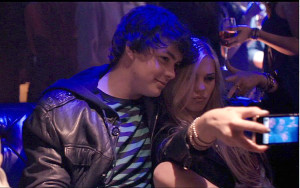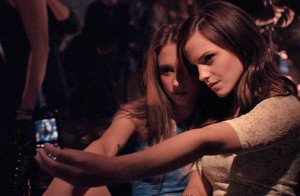I must issue a small disclaimer in that I am a very big fan of Sofia Coppola, and this will be praising her/her film — if you are not interested in or happen to dislike her films, this might not be your type of post. Thank you!
When it comes to accuracy, even some of the simplest details can prove to be extraordinarily important. In films made in the present day that are supposed to take place a few years prior, one might overlook some of these small details — perhaps they will believe that it doesn’t matter enough, or that something doesn’t change in only a few years. Yet this is entirely not the case — especially in more recent years, and especially with regard to technologies, things change all the time.
Because of this, it becomes even more crucial to pair up the costuming and set to the year.
In Sofia Coppola’s film, The Bling Ring, she manages to do just that. Of course, nothing can be perfect, but with the little details that she throws into the film it really does appear to be a throw-back to roughly 2008. In many regards, it could take place now — but certain elements of it jump out as being from a time that isn’t too long ago, but is also clearly not nowadays.
One of the first shots we see in the film is that of the character Marc’s Facebook page:
Now, of course the upper left-hand corner would normally read ‘Facebook’, but films and television programs often make up site names, so using the character’s name makes perfect sense. I got a Facebook around 2008, and I can remember when it used to look something like this. As most users of Facebook can tell you — Facebook likes to switch around its layout and settings quite a bit. Because of this, if Marc were to have the new timeline-with-background combo, the movie clearly would be in the year that the film was released, and clearly not 2008, with Facebook’s ‘view your profile as a different person’ option and overall slightly more simple layout.
In doing this, the film states “this is something important and relevant even into today, but it took place before now.” It highlights that the film is based off of a true story — because if it were simply a new film about our self-obsessed culture, why not make it take place in the year it was released?
Another notable item is that of the selfie-taking scenes.
What is interesting about these are the angle of the phones. This was before iPhones and other smart phones had the ‘flip’ option through which one can more easily take a selfie. So when Chloe, Marc, Nicki, and Sam take photos of themselves, the physical act of flipping their phones adds a great deal to the way in which the film itself is received.
I remember feeling elated about these aspects of the film as I left the movie theater back when I first saw The Bling Ring, and I am still incredibly pleased and grateful for the way in which they were incorporated.
For this post, I chose to focus more on outside parts of costumes — I am aware that cellphone position and edition of Facebook are not technically costumes, but as I am also interested in the accuracy (successful in this case) of the way that films are created, I figured that those two items would make interesting subjects to focus on.
Part of what I love most about The Bling Ring is the way in which it analyzes the current culture. And while it focuses on teenagers, the messages it implies can be applied to people of many generations. We live in a culture that is often so self-obsessed, but not only that. (Selfies are not bad. If you feel confident in how you look, and you are not harming anyone else, there is no harm in showing off how you look! But that’s another topic for another time). As a society, we strive so desperately to emulate those who we admire — but not always because we admire a person’s humanitarian efforts. We see that they lost weight, or that they like a certain style of dress, and that is what we want to be.
This film shows that perfectly. The teenagers seem to believe that if they steal from A-list celebrities, somehow their lives will improve and they will find love and success. Their clothing changes throughout the film — from more simple clothes in the beginning (though most of them started off with a decent amount of money and therefore ‘simple’ is a somewhat relative term) to tighter and more show-offy clothing by the time the film has ended. They will make any and every effort to become the celebrities that they see at a favorite club and read about in magazines and online.
But instead of becoming a new super star, each character manages to prove just how lost and without a true and solid identity they are. They may dress in clothing stolen from celebrities houses, or clothing purchased with stolen money, but they are even less of individuals by the end of the film then they were in the beginning. They are so afraid of losing their status and power that they manage to lose themselves in the process.



